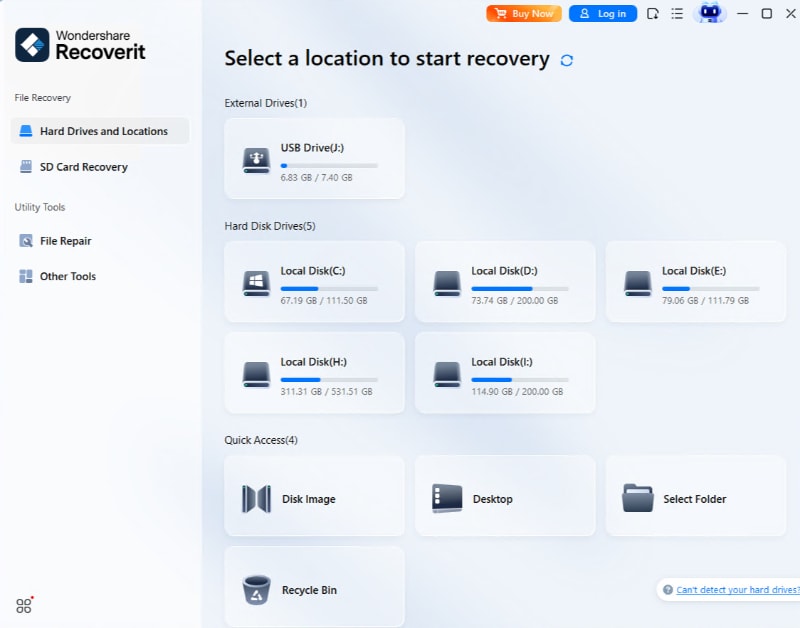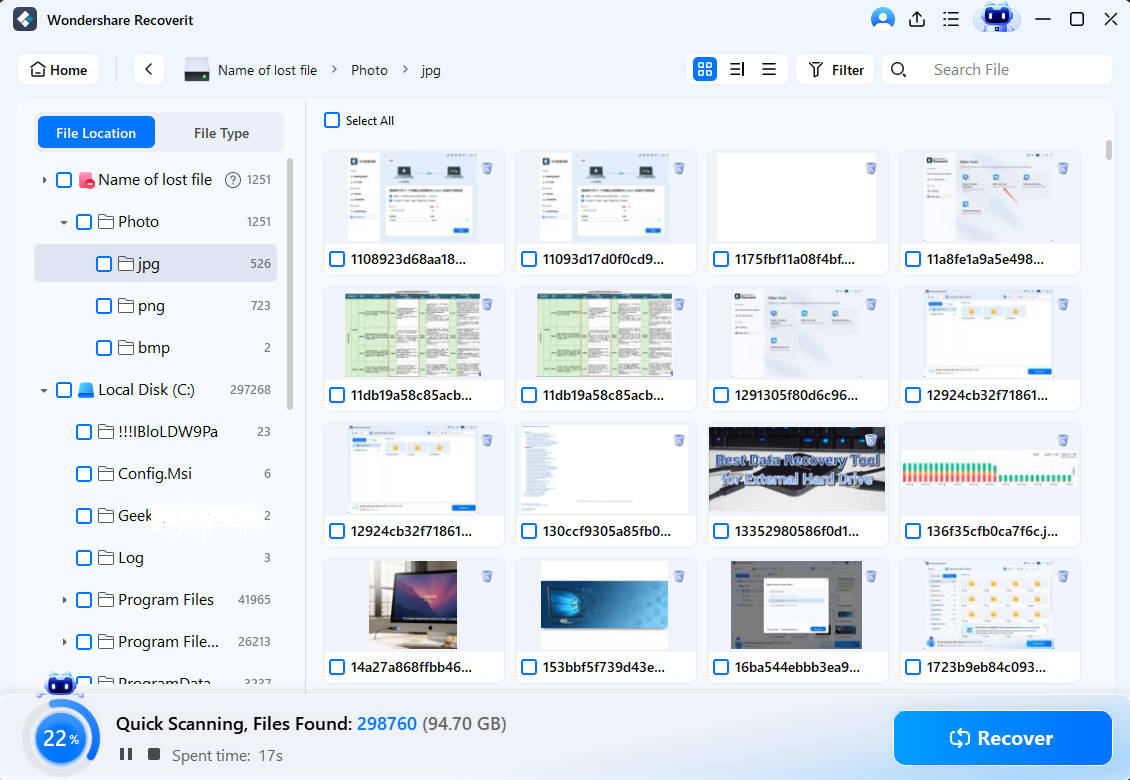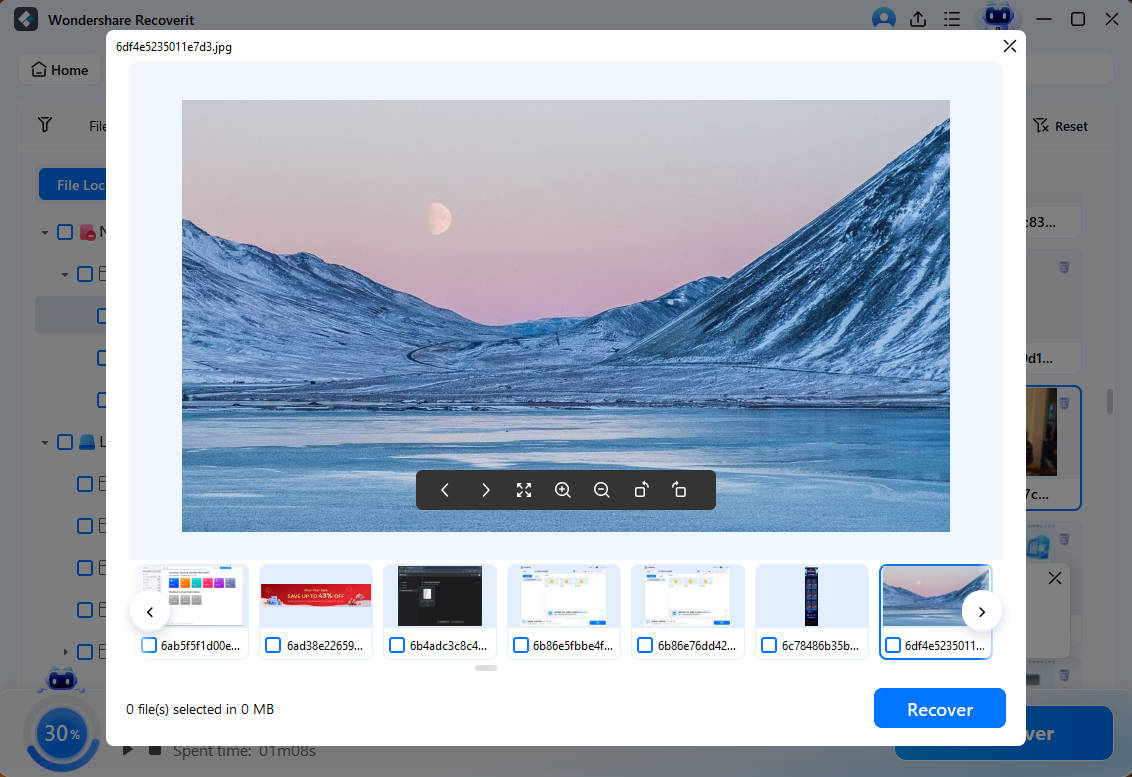My drive isn't showing up on my computer and it is making beeping noises once every 2 second. How to recover data or just get my external hard disk drive working again? - from Microsoft Community
Are you looking for ways to recover deleted files from an external hard drive due to human error, formatting, file corruption, malware, or other unforeseen circumstances? We've rounded up eight proven methods for external hard disk data recovery.
Whether you need to recover photos from an external hard drive or restore other HDD data, you'll have it back on your device before you drink your morning coffee. Let's see how to retrieve files, what causes hard disk data loss, and how to avoid it.
Table of Content
-
- Seamless External Hard Drive Recovery With Recovery Software
- Go to Your Backup Solution for Quick External Hard Disk Data Recovery
- Use Recycle Bin to Recover Deleted Files From an External Hard Drive
- Use Hidden Items to Restore Files From an External Hard Drive
- Retrieve Data From an External Hard Drive via the File History Feature
- Run the External Drive Recovery From the Windows System File Checker
- Recover Files From an External Hard Drive With Windows Command Prompt
- Let a Professional Recover Deleted Data From Your External Hard Drive
External Hard Disk Data Loss: Causes & Solutions
The most widespread causes of external HDD data loss include the following:
- 🗑 Accidental deletion
- 🧹 Disk formatting
- 🕷 Malware or virus attacks
- ⛔ Software malfunction
- 💽 Disk corruption
- 💻 System crashes
- 🔂 Interrupted data transfer
- ❗ Firmware corruption
- 🔨 Hardware failure
Fortunately, external hard drive recovery software, manual methods, and professional data recovery services can restore HDD data in these and other data loss scenarios. However, some mistakes make external hard disk recovery impossible.
Top 3 Mistakes That Make External Hard Disk Recovery Impossible
The following mistakes lower, if not eliminate, the chances of successful external hard drive recovery:
- Continued use after data loss - Using your external HDD after formatting it, accidentally deleting files, or experiencing other data loss issues will overwrite your data, making retrieval impossible.
- Leaving your external HDD in extreme heat - High temperatures can damage it and lower the odds of restoring data.
- Water damage - Spilling water or other liquids over your external hard disk can cause a short circuit and irreversible data loss. The same goes for storing it in a humid environment.
Professional hard drive recovery services might be able to help in these situations, but the chances are slim. On a lighter note, here's how to recover files from an external hard drive in case of those reversible data loss scenarios.
How To Recover Files From External Hard Drive With 8 Proven Methods
The following external drive data recovery methods are the best for retrieving lost files in any data loss scenario, including software and hardware failure.
Method 1. Seamless External Hard Drive Recovery With Recovery Software
External hard drive data recovery software is your best bet for restoring HDD files. Wondershare Recoverit - Hard Drive Recovery is among the leading solutions, with billions of users worldwide.
It can also recover data from disk images, an emptied Recycle Bin, SD cards, USB flash drives, and other external devices. As for portable hard drive data recovery, it can restore single files, selected folders, partitions, and the whole disks.
Here's how to retrieve data from an external hard drive with Wondershare Recoverit:
- Connect your external hard drive to the computer.
- Download, install, and launch Wondershare Recoverit on your computer.
- Select Hard Drives and Locations and choose the connected disk under External Drives.

- The program will start an automatic scan, so wait a few minutes.

- Once your lost files appear, select those you wish to retrieve and click Recover. You can also preview them to ensure everything is in order.

Additionally, Wondershare Recoverit stands out for its patented Enhanced Recovery technology that can patch fragmented video files. We highly recommend it for portable hard drive data recovery if your HDD has videos you shot with a professional camera. It can also recover deleted photos from an external hard drive without quality loss.
Method 2. Go to Your Backup Solution for Quick External Hard Disk Data Recovery
Have you backed up your external HDD to your computer, another device, or the cloud? That's the best way to avoid data loss. You can recover deleted data from the external hard drive or lost files due to unexpected disk problems.
However, this external HDD data recovery method restores files from a previous backup. It can't retrieve the data you stored after backing up the disk. Still, it's excellent for recovering at least some (if not most) data.
Method 3. Use Recycle Bin to Recover Deleted Files From an External Hard Drive
Can the Recycle Bin recover data from an external hard drive? Yes! In fact, Recycle Bin is considered the primary way to recover deleted files from external hard drives or any other location. Your external hard drive's Recycle Bin keeps deleted folders and files until you permanently empty the bin and overwrite the space with other data.
Here's how to restore deleted files from an external hard drive's Recycle Bin:
- Connect your external HDD to your computer. That way, you'll see combined Recycle Bin data.
- Open the Recycle Bin, navigate to the Manage tab, choose what to retrieve, and click Restore the selected items.
- Alternatively, you can recover all deleted files and folders or right-click any and hit Restore.

Method 4. Use Hidden Items to Restore Files From an External Hard Drive
This method works if you haven't deleted files from your external hard drive. You can use it to check if they still reside on the external hard disk but are invisible. It shows hidden items so you can quickly retrieve them.
Why would your external HDD hide files in the first place? A virus or malware infection might be the culprit, which can also delete data. Other causes include file system errors and corruption, which often make files disappear seemingly or literally.
Here's how to retrieve files from an external hard drive using the Hidden items feature:
- Connect your external hard drive to your computer.
- Launch the This PC app and navigate to the View tab.
- Tick the Hidden items checkbox.

You'll see all hidden folders and files on your computer and the connected external HDD.
Method 5. Retrieve Data From an External Hard Drive via the File History Feature
While older Windows had Backup and Restore, newer versions (Windows 8, 8.1, 10, and 11) have File History, an automatic data backup and restoration feature.
The best part? It backs up all previous file versions and lets you save data to an external hard drive or a remote network location. That way, you can retrieve data from an external hard drive anytime without worrying about data loss.
Here's how to recover lost files on an external hard drive from File History (assuming you've enabled it and backed up your portable HDD data):
- Connect your external HDD to your computer.
- Navigate to Settings > Updates & Security > Backup > More options.
- Click Restore files from a current backup.

- Select the folders or files you wish to recover, click Settings (the gear icon) > Restore to, and choose your external HDD or other destination. Alternatively, click the green Restore button to restore the selected items to a default location.

Method 6. Run the External Drive Recovery From the Windows System File Checker
The Windows System File Checker (SFC) is a built-in utility for scanning and repairing corrupted system files on your PC. It can also help you restore external hard drive, primarily if you lost it due to malware or an unexpected system crash.
Here's how to recover files from an external hard drive with the Windows SFC:
- Connect your external HDD to your PC.
- Use the Windows + S keyboard shortcut to open Windows Search.
- Type Command Prompt or cmd and select Run as Administrator.
- If you use Windows 8 or newer, run the following command: DISM.exe /Online /Cleanup-image /Restorehealth. That will run Deployment Image Servicing and Management (DISM), a command-line tool that scans for corruption and restores missing files.
- Once the progress bar reaches 100%, run this command: sfc /scannow. That will scan all system files before pulling cached copies of corrupted or missing data and restoring it. Use this command regardless of your Windows version.
- The system scan will take a while, so don't close the window. Once the verification is 100% complete, type exit and press Enter.

The Windows SFC command is sometimes enough to repair corrupted or replace missing files. The “Resource Protection did not find any integrity violations” message indicates success. However, if it fails, run the DISM command to restore the data (regardless of your Windows version) or rerun the SFC scan in Safe Mode after restarting your PC.
Method 7. Recover Files From an External Hard Drive With Windows Command Prompt
Like the previous method, this one also requires running Windows Command Prompt, but it's much more straightforward. You only need to execute one command to fix all attributes of missing, inaccessible, or deleted files on your internal and external hard drive.
Here's how to recover lost data from an external hard drive with Windows CMD:
- Connect your external hard disk to your PC.
- Use the Windows + R keyboard shortcut to open the Run command window.
- Type cmd and press Enter or click OK.
- Run the following command: ATTRIB -H -R -S /S /D X:*.*, ensuring you type your external HDD's drive letter instead of X.

This command removes the hidden, read-only, and system attributes and searches for lost files in all folders and subfolders on your external HDD. Once it completes, you'll see the retrieved data in a new folder.
Method 8. Let a Professional Recover Deleted Data From Your External Hard Drive
Professional hard drive recovery services are best for external hard drive failure recovery when physical damage is at play or if the methods above don't bear fruit. Experts have high-end equipment, advanced tools, and experience repairing HDDs and other storage media and can fix yours quickly.
Therefore, contact a reliable professional to recover lost data from an external hard drive. They'll run diagnostics, identify the problem, and get your disk up and running again if it isn't beyond help. Moreover, they'll recover your deleted or missing data.
Contact them beforehand for a quote and ensure they won't charge you for unsuccessful data retrieval.
Why It's Recommended to Use External Hard Drive Data Recovery Software

External HDD data recovery software can help retrieve deleted files from an external hard drive. That's fantastic if you accidentally erase them and don't have a backup.
Additionally, it can recover lost files due to malware, viruses, system crashes, formatting, and other data loss scenarios. You don't have to worry about losing precious data because the software can retrieve it within minutes (in most cases).
Data recovery solutions like Wondershare Recoverit have advanced algorithms for identifying and restoring lost or deleted data and repairing corrupted files that have become inaccessible or unreadable.
They're the best tools for data retrieval when your external hard drive is acting up due to software issues, system crashes, or human error. Professionals can step in to fix physically damaged disks and attempt data restoration.
How To Fix the External Hard Drive not Detected and Recover Data?

If your PC doesn't detect your external hard drive, try these methods to fix the problem and recover files from external hard drive that is not detected:
Method 1. Check the Connection and Cables
Your USB cable may be loose or damaged due to wear and tear. Check the connection and try another USB cable to see if your PC will recognize your external hard drive.
Method 2. Try a Different Port or Computer
Another computer might detect your external HDD if your primary device has a problem preventing it from recognizing your portable disk or isn't compatible with it. The same goes for a different USB port because the one you initially used might be faulty.
Method 3. Update Device Drivers
Your disk drivers might be outdated or have developed a bug, so updating them might fix the detection problem. You can also uninstall and reinstall them. Here's how:
- Connect your external hard drive to your PC.
- Use the Windows + R keyboard shortcut to open the Run command window.
- Type devmgmt.msc to run Device Manager and hit Enter or click OK.

- Expand Disk drives, right-click your external HDD, and click Update Driver Software. Alternatively, click Uninstall and restart your PC. Your computer will install the latest drivers once it powers back on.

Method 4. Format the Drive
If all else fails, you can format your external hard drive. However, that means data loss, so use this method as a last resort if you haven't backed up your data. In case you need to format the drive without a backup, fret not, as data recovery software can assist in recovering data from a formatted external hard drive.
Here's how to format your external hard drive if your PC doesn't recognize it:
- Connect your external hard disk to your PC.
- Use the Windows + R keyboard shortcut to open the Run command window.
- Type diskmgmt.msc to run Disk Management and hit Enter or click OK.
- Right-click your external hard drive and click Format.

- Follow the on-screen instructions and choose the NTFS or the FAT32 file system.
Your external hard drive should be as good as new after formatting, and your PC should detect it.
Video Tutorial on How to Fix External Hard Disk Detected but Not Opening Issue?
How To Avoid External Drive Recovery in the Future
To minimize the need for external drive recovery in the future, it is essential to take preventive measures and maintain good habits when it comes to data management and storage. Here are some tips to help you avoid external drive recovery scenarios:
| Tips | Explanations |
|---|---|
| Regular backups | Regularly back up your important data to multiple storage devices or cloud storage services. This ensures you have multiple copies of your data, reducing the risk of losing it due to hard drive failure or corruption. |
| Use reliable hardware | Invest in high-quality external hard drives from reputable manufacturers. These drives are built to last and are less likely to develop bad sectors or other issues that can lead to data loss. |
| Proper handling and storage | Handle your external hard drive with care, avoiding drops, jarring, or exposure to extreme temperatures, humidity, and magnetic fields. Always store the drive in a safe, dry, and temperature-controlled environment. |
| Safely remove the drive | Always safely eject the external hard drive before physically disconnecting it from your computer. This prevents data corruption and potential damage to the drive. |
| Keep your computer and software up to date | Regularly update your computer's operating system and software to ensure they are running smoothly and efficiently. This reduces the chances of software-related issues causing data loss or hard drive corruption. |
| Use antivirus and security software | Protect your computer and external hard drive from malware and viruses by using reliable antivirus and security software. Regularly scan your external drive for any potential threats. |
| Monitor hard drive health | Use built-in or third-party tools to regularly check your external hard drive's health, including monitoring for bad sectors. Early detection of issues can help you take necessary action to prevent data loss. |
| Defragment the drive | For hard disk drives (HDDs), regularly defragmenting the drive can help improve performance and extend its lifespan. Note that this step is not necessary for solid-state drives (SSDs). |
By following these tips and practices, you can significantly reduce the likelihood of needing external drive recovery in the future, ensuring the safety and integrity of your valuable data.
Conclusion
Whether your external hard drive is acting up or you've accidentally formatted the disk or erased data, it doesn't have to mean irreversible data loss. You can recover deleted files from an external drive with data recovery software like Wondershare Recoverit or other methods above.
However, backing up your portable hard drive is the best preventative measure, so secure it in several locations to avoid the stress and headache of losing precious data.
FAQs About External Hard Drive Recovery
-
How can I recover deleted files from an external hard drive?
The best way to recover deleted files from an external hard drive is to use data recovery software like Wondershare Recoverit:- Connect the external hard drive to your computer.
- Download, install, and launch Recoverit on your PC.
- Select the external hard drive and start scanning for lost files.
- Preview the scanned files and choose the desired ones.
- Click Recover and choose a location to save the recovered files.
-
Is it possible to recover data from a dead external hard drive?
If a logical error is the culprit, you can recover data from a dead external hard drive with data recovery software. However, if your portable disk has suffered physical damage, only a professional data recovery service might be able to help. -
How much does it cost to recover data from an external hard drive?
Restoring data from an external hard drive with logical errors costs between $60-$200. Fortunately, you can recover it for free with a reliable data recovery solution like Wondershare Recoverit for free. However, if there's physical damage, you'll need to leave data retrieval to expert technicians and pay between $500-$3,000, depending on the extent of mechanical failure. Still, some professionals don't charge for unsuccessful data restoration. -
Can I recover data from an external hard drive that is not recognized?
You can recover data from an unrecognized external HDD. Check the connection and cables, try another computer and USB port, update device drivers, or format the disk after backing it up with a reliable backup manager like Wondershare UBackit.



 ChatGPT
ChatGPT
 Perplexity
Perplexity
 Google AI Mode
Google AI Mode
 Grok
Grok























